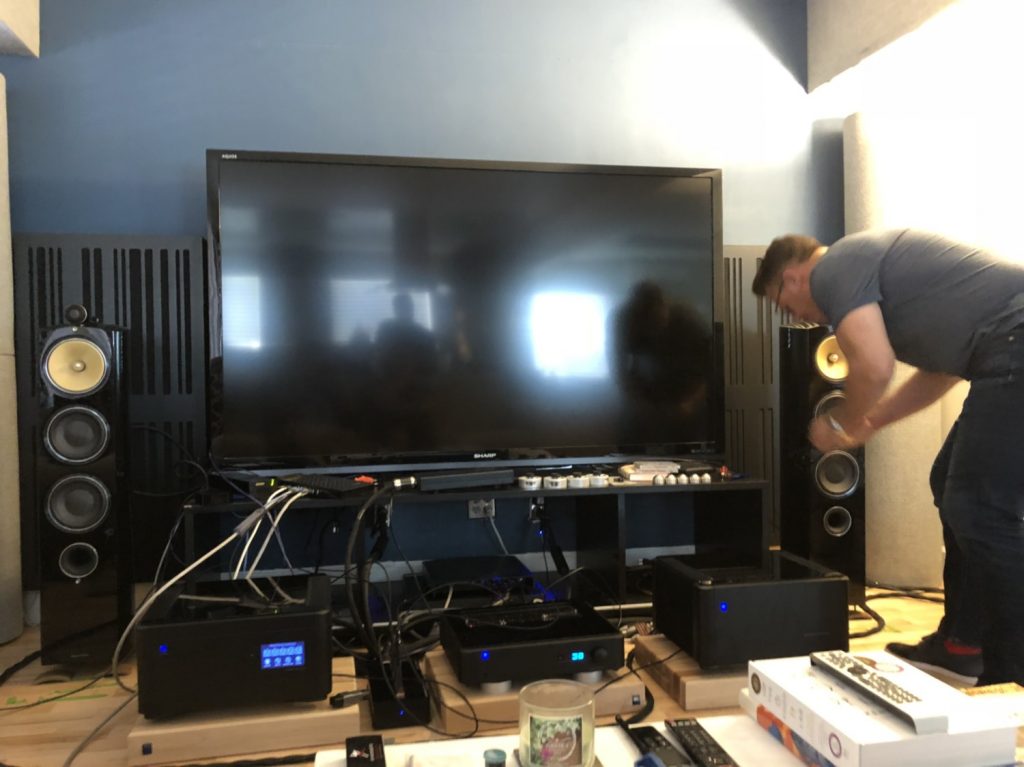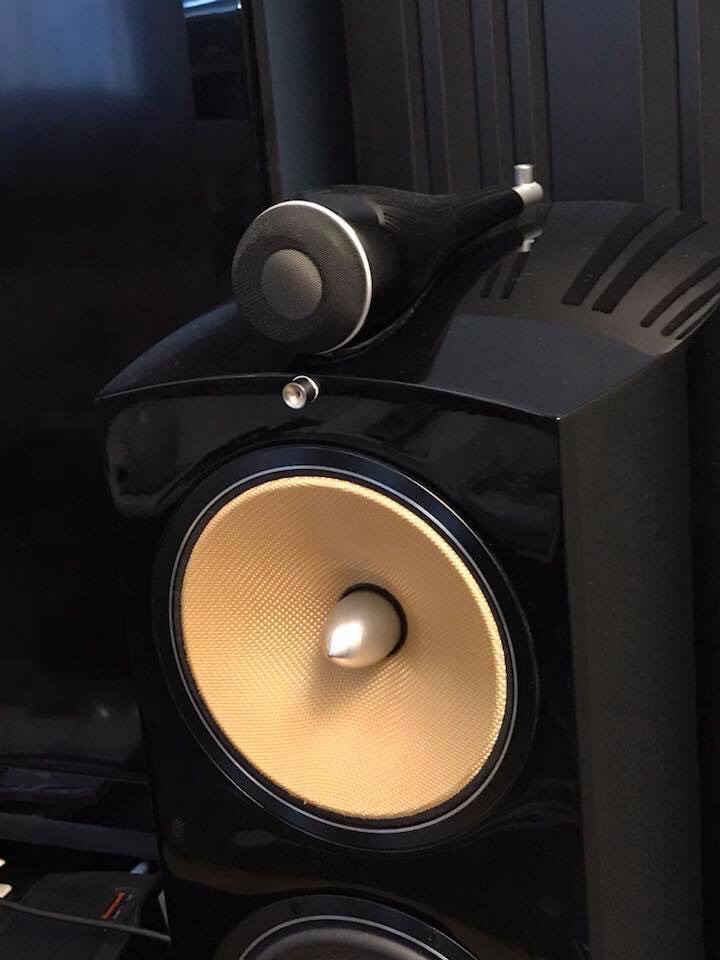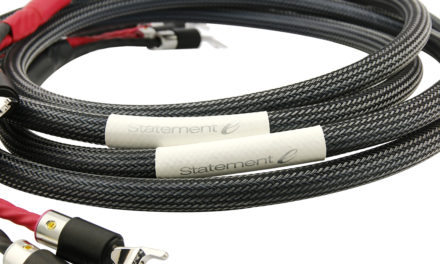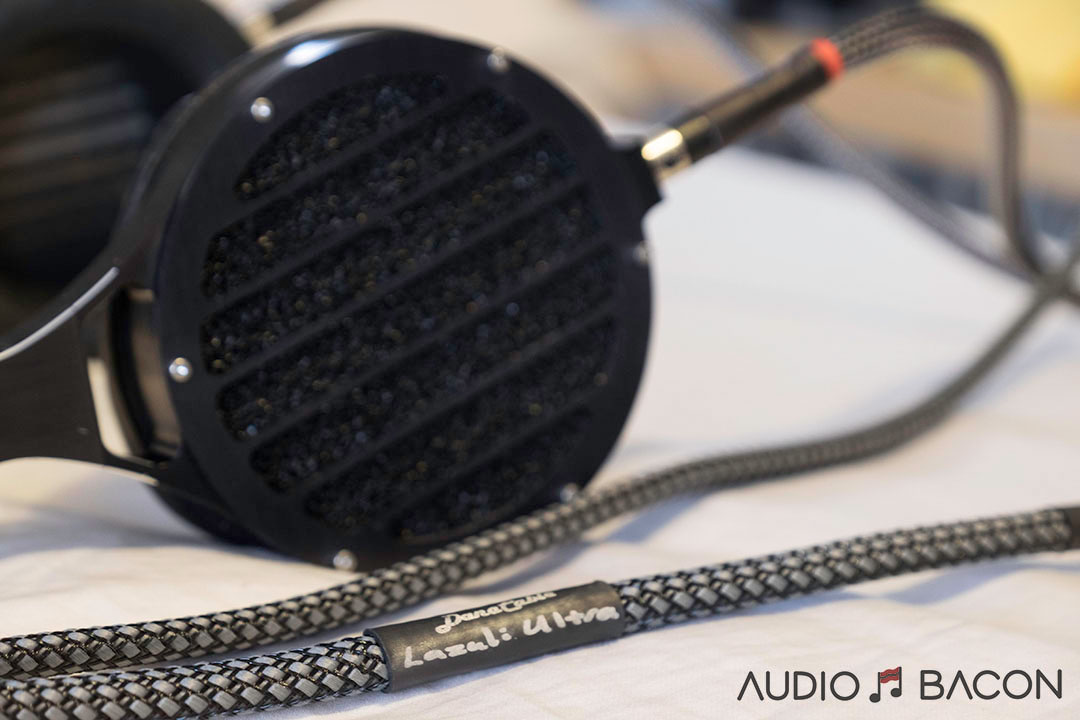I’ve been curious about Synergistic Research products since I’ve acquired their Synergistic Research Atmosphere Level 3 HC Power Cord and their BLACK Quantum fuses. These products have brought new life into my system in ways I didn’t imagine possible. It went from a veiled and congested sound to something more quiet, dynamic, vivid, and most importantly, musical.
I met Ted Denney, lead designer of Synergistic Research, at Rocky Mountain Audio Fest back in October, and it was quite the interesting experience. With over 25 years of being in the business, he apparently knows more than a thing or two about psychoacoustics. We traded bits over how the SR products worked, and how I could be getting more out of my system. Ted’s view was that I needed to be working with a full set of Synergistic Research (SR) gear, and having one SR power cable paired with some Shunyata cables, and others were akin to running a Ferrari with four different tires.
At the time, I disagreed. Traditionally, for most audiophiles building systems; it’s not always practical to replace an entire loom of cables, or make big wholesale changes. I believe most guys will build up component by component, going through cycles of upgrades, matching up components to their needs. For example, when I needed to include a second set of XLR cables to accommodate my PS Audio BHK Signature Preamp, I already had a certain sense of what I wanted out of the cables; and as a result, I ended up with a pair of High Fidelity Cable’s Reveal series XLR cables. In tandem with my Audience Au24 SX XLR cables, it gave me the correct balance of warmth, detail, and punch that I was looking for. I guess you can say we agreed to disagree a bit.
At the same time, Synergistic Research pulled one helluva demo at RMAF. They had a room rigged out with their products and proceeded to go through each major line to illustrate how it impacts the music. All in all, the whole demo took nearly 30 minutes and was one of the most meticulous and convincing demos at the show. While it’s difficult to isolate what each component is doing at a show, you certainly get an idea what they’re about. Being a SoCal local, Ted and Andy Wiederspahn offered to set up some SR gear, walk me through the process, and provide some education. That was something to really get excited about, especially when one can experience and break things apart on your home turf.
Months later, we finally got around to hanging out with some duck confit & fine Irish whiskey at my place. We chatted about everything from food & whiskey to industry, life, and everything in between. It was a tremendous experience and also very insightful to get a better understanding of how their products work. And I have to say, the last few weeks with some of their equipment have really changed my views, and this next series of articles will try to articulate that.
Synergistic Research’s approach to understanding energy, sound, and it’s physics is unlike any other company out there. Reading their literature might read like some pseudoscience and not in the kind of texts that traditional audiophile engineers are used to. In conversations with Ted, there’s actually quite a lot of science behind it, and they also have their own proprietary ways of measuring & testing their designs. However, it’s not something they’re willing to readily disclose as that will essentially give away their secret sauce. That’ll drive the objectionists nuts because they’ll debate with you for days why something works and why something doesn’t. What’s missing in that approach is the humanistic nature of music and emotions, and undermines the complexity of the human ear. It’s also why Synergistic Research is so open about their 30-day risk-free trial. Try their stuff, and if you’re not happy; you can go ahead and return it to your dealer. At the end of the day, our best tool is our ears and you should always trust them. If you can tell me how to measure the things we hear with regards to the timbre, soundstage, and musicality; I’ll gladly make those measurements.
This article is going to be the first in a series and will speak to Synergistic Research as a whole, how their components work together, and their recommendations on how to begin to dive in. From there, I’ll post individual articles/reviews talking about their PowerCell 12 UEF SE Power Conditioner, the Active Ground Block SE, and the HFT system in conjunction with Black Box. The individual articles will get into some of the specifics, but I thought it was more important to get an understanding of the whole picture first.
Synergistic Research’s products are very unique and in many ways, requires a tweakers mindset. The aspect I’m impressed (and a bit perplexed by too) is how each of their products works off each other and you seemingly get an exponential return on each product as you layer on more Synergistic Research products. For example, I noted the differences heard in the Active Ground Block in my December purchase. It was quite dramatic and will be detailed in the forthcoming review, but after Ted was done setting up the HFTs and Black Box, I was even more astounded by the greater difference the Black Box exhibited. In a later experiment and much to my chagrin, I unplugged the Active Ground Block and the impact was actually more profound than before. It almost seems as if their technologies are built off each other and developed an exponential return. It’s quite a slippery slope as I have some time scheduled for them to come back and let me audition their interconnects & speaker cables. I’m a little worried about my wallet to that outcome!
With all of this said, one might ask “Where do I begin?” It’s not always practical to make giant wholesale changes to one’s system with all the money being asked to be shelled out. Ted suggests starting with his power conditioning solution. Power hits your system and percolates the rest of the signal path. Makes sense. Note that the high price point of the PowerCell 12 UEF SE ($6,495) does include the outlet ($249.95), and a specially engineered version of his Level 3 Atmosphere cable ($3,395). That essentially makes it cheaper than many of the power conditioners out there and you won’t have to go through the headache of mixing and matching power cords.
Ted then suggests getting into the HFTs and Blackbox because this is the energy coming out of your speakers and where you get the last point of impact before it reaches your ears. The HFTs are actually a fair bargain compared to other types of upgrades you can be making (more details to come on that later).
From a hobbyist perspective, I would actually recommend looking into the Active Ground Block or HFTs first if you already have some form of power conditioning. The idea is that you probably won’t have a grounding solution yet, or something like what the HFT’s do; so going from nothing to something will be more of an upgrade.
In the meanwhile, stay tuned over the next few weeks as I continue to review the individual products.
They’ll be properly linked when completed.
- Active Ground Block SE
- Atmosphere Level 3 Power Cable & Fuses
- Room Acoustics Products (HFT’s, Blackbox, Atmosphere XL4)
- Powercell UEF 12 SE (which includes the Powercell UEF 12 conditioner, a specially modified Atmosphere Level 3 Power Cable, and UEF Black Duplex Outlet)
- Isolation products (Tranquility Base UEF, MiGs), Excite Interconnects and Speaker Cables.













You are either tone deaf or totally delusional to fall for this guy’s scam. The guy had zero credentials other than marketing and couldn’t create a piece of electronics to save his life. It’s just snake oil crap to fool gullible Audiophiles who have no clue.
Many people have cracked open his crap to prove its just that. All you’ve proved with this article is that you have zero credibility and that the placebo effect (as well as his various in person marketing tricks) work.
Scam Buster –
Would love to hear some details of your personal experience with their products and how that lead to your conclusion. Synergistic Research does have a house sound of sorts– airy/holographic in dimension, low noise floor, and very transparent but musical. However, I do think that the transparency can lead to some less than stellar initial impressions when using one or two of their products because what it also did was expose a flaw elsewhere in the system that might have been masked or balanced with other components.
If you have not tried their products, I encourage to give their products a try. Synergistic Research offers a 30-day money back guarantee and most serious dealers will be pretty generous in their audition process. Do make sure you give ample time for the products to break in and settle into your system. Some products like their Quantum Black Fuses will sound great one day, and terrible the next until it’s fully broken in.
Also, please follow along and read some of the detailed notes we have composed. While Ted did help guide us through some initial setup, we’ve spent a ton of time doing listening sessions with multiple competitive products. Additionally, Audio Bacon does not take any sort of paid sponsorships or ads from manufacturers in the industry. The only ads you see are Google generated and up to whatever algorithm they use.
Cheers,
Siao
I go to all the shows, listened to his phony demos, and speak to many of the manufacturers that actually have engineering credentials.
If you want to be a respected review site, I suggest you do the same and learn exactly what a scam artist this guy is. You won’t see his gear in any other room. You will never get measurements and never see him do a DBT… despite him claiming that he does DBTs at his facility.
You had enough people at your “review” to do a simple DBT, but you didn’t which speaks volumes. There’s a reason he flies and drives to the reviewers house to influence gullible reviewer wantabes.
As I mentioned previously, there is tons of evidence online where people cracked open his stuff to show it’s a scam.
Why don’t you do your own measurements with just the black box? Tell us exactly what changed in bass frequencies. It will be zero.
Why not do a blind test with your buddy using the HFTs and record it? If you can guess right 10/10 times then you should nominate this guy for a Nobel prize.
Examine the connectors on his cables. He doesn’t even pay for legitimate furutech or oyaide. He just gets Chinese knockoffs… Probably from AliExpress.
Better yet… If you still can’t see the invite, put your money where your mouth is. I’ll be at the LA audio show and we can setup a DBT where you can prove what you wrote. How much are you willing to wager that you can identify HFTs in the room? Black box? Power cable?
Oh… And before you recite his 30 day money back guarantee excuse… Realize that this is exactly the same tactic used by infomercials… Not respected brands.
You are 100% wrong about Synergistic Research. More and more of my friends who have large music collections respect and use many (not all) of their products. Among the most cost effective are the SR black duplex, SR blue fuses, HFTs, then more expensive, Blackbox and Atmosphere XL4. We appreciate the difficulty in setting up an audiophile high quality sound system and SR helps us achieve that. I am not a shill or promoter for the company and have spent a lifetime in the music field. I’ve heard competitive products which sometimes are easier to use that do similar things (Schnerzinger room wave energizer at $10K to shart with and do not require any other equipment), Furutech and Oyaide duplexes and fuses. These are tweaks for high resolution (or to bring them to higher resolution) audio systems. Tweaks are system specific and cannot be applied willy nilly. They often have no scientific papers to back their engineering concepts. But they can work and work well, they add value to their owners.
You have zero idea of what you’re talking about! I’m 100 percent certain you’ve never heard 1 synergistic product at all but have crowned yourself the expert of all things audio!
All I’ll say is that many reviewers ,from Stereophile to webzines, have praised SR demos, for years…
I’ve been having a play around myself with the SR gear, had the Black Box in the room which I must say is excellent, I’m now having a ply with the HFT and currently running on level 1, I must admit they do do something and if you get the chance in your system then I’d suggest to have a go
Yeah, actually we’ll have a forthcoming review on that. We initially purchased a Black Box first based on what I thought I needed; but Ted later explained that the HFTs are actually more the foundational piece and in some ways, something you should have first before the Black Box because it increases the performance of it with the HFTs
Hey Lee, just realized I forgot to follow up, but we recently did post our observations and notes on SR’s line of acoustic treatment products (HFTs, Black Box, and the Atmosphere)
https://audiobacon.net/2018/06/20/synergistic-research-hfts-black-box-and-atmosphere-xl4/
Cheers,
Siao
i think the rubber meets the road with dbt tests. years ago, when i fell for monster cables bullshit lies and marketing nonsense, i bought a pair of ‘power II plus’ speaker cables and ‘x-terminators’ (15’ about $1,050.)
my wife came home and saw the huge ass cables and said: “tomorrow i’m going to the hardware store and i’m gonna buy $2 worth of 16 gauge lamp cord. we’re gonna hook it up a/b style and you better get it right 10 out of 10.
i told her i didn’t want to play her little game.
the next system, and every one thereafter, had ‘blue jeans’ custom cut cables for a fraction of the price and the best signal transfer possible.
live and learn. as the article says: -gotta have a tweakers mindset… snake oil, anybody?